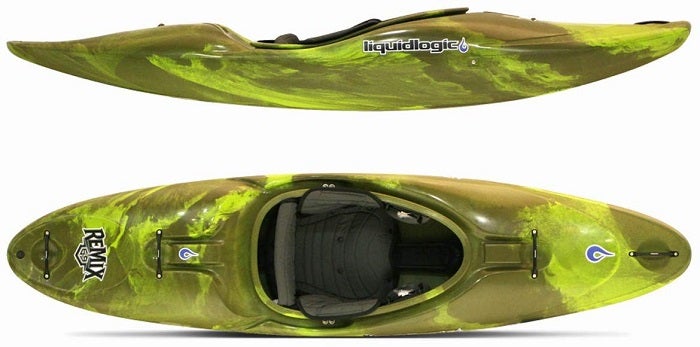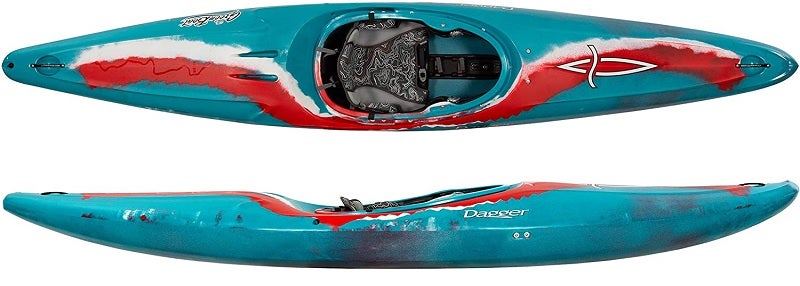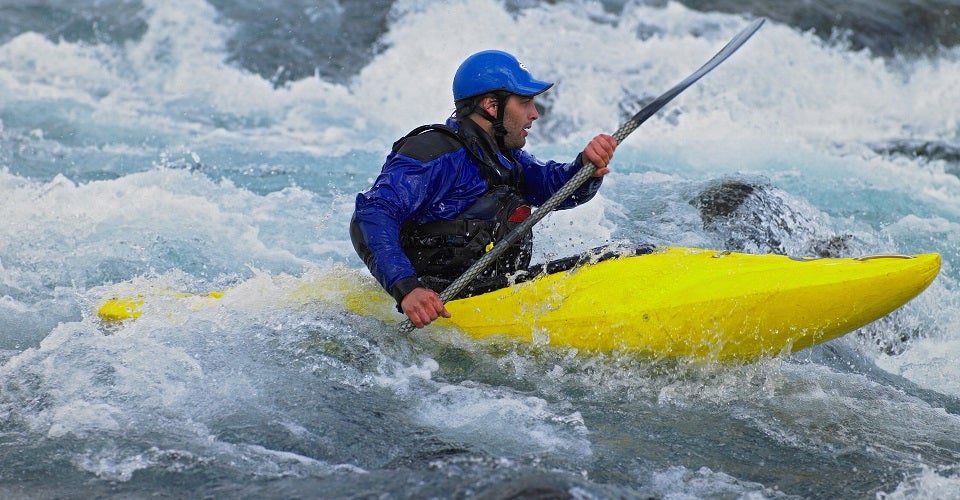
Our Editors independently research, test, and rate what we feel are the best products. We use affiliate links and may receive a small commission on purchases.
Whitewater kayaking takes paddling sports to a whole new level. If you’re an adrenaline junky and you love athletic endeavours then whitewater kayaking might be your bread and butter!
That said, whitewater kayaking is much more complicated and dangerous than other forms of paddling.
For that reason you really should take a few lessons and work with an experienced local outfitter while you’re learning. Mistakes can cost you your life in this sport.
After you’ve had some introduction to the world of whitewater kayaking, it might be time to find your own kayak! Getting the correct boat for you means first understanding the basics of whitewater kayaking.
Once that’s out of the way we’ll help you understand the differences between boats and guide you toward a few of the best options out there today.
Best Whitewater Kayaks
| Jackson Kayak Antix 2.0 Whitewater Kayak | Jackson Kayak Rock Star 4.0 Kayak | Driftsun Rover Inflatable Tandem White-Water Kayak | |
|---|---|---|---|
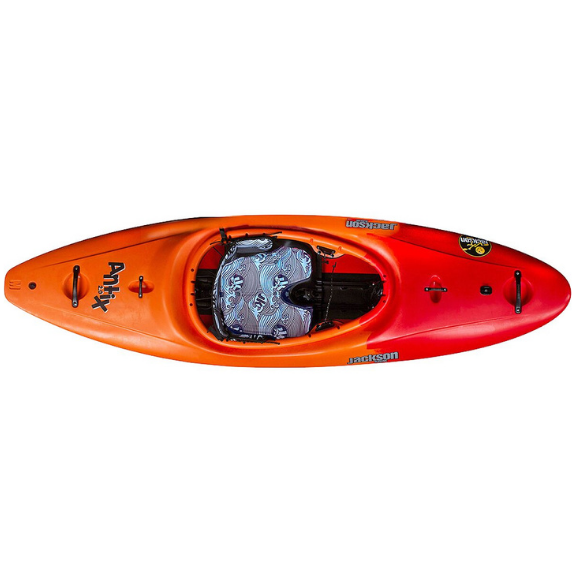 | 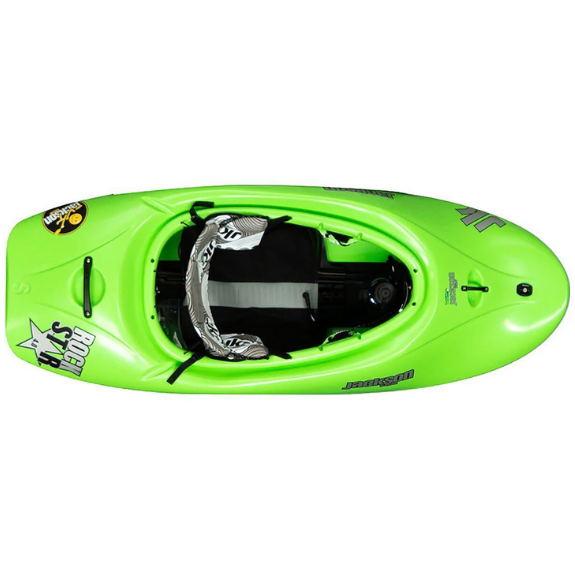 | ||
| Length: | Three Sizes ( 7ft 7in, 8ft, 8ft 5in) | 7’ 8” | 12.5′ |
| Weight: | 34-42 lbs | 27-34 Pounds | 28 lbs |
| Weight Capacity: | 160-230 lbs | 150-250 lbs | 600 lbs |
| Material: | Polyethylene | Not specified | 1000D Reinforced Layered PVC |
| REI.com | REI |
Quick Answer: The 7 Best Rated Whitewater Kayaks For 2021
- Jackson Kayak Antix 2.0 Kayak
- Jackson Kayak Rock Star 4.0 Kayak
- Driftsun Rover Inflatable Tandem White-Water Kayak
- Dagger Torrent Sit-On-Top Whitewater Kayak
- Liquid Logic Remix 47 Whitewater Kayak
- Dagger Nomad 9 Sit Inside Whitewater Kayak
- Dagger Green Boat Whitewater Long Boat Kayak
Our reviews of the top rated whitewater kayaks along with a comparison table and buyers guide will help you choose the right one for you.
Let’s take a look at how to choose a whitewater kayak and which ones might be worth considering as you pick your next boat!
Whitewater Kayak Reviews
#1 Jackson Kayak Antix 2.0 Whitewater Kayak
- Length: Three Sizes ( 7ft 7in, 8ft, 8ft 5in)
- Weight: 34-42 lbs
- Weight Capacity: 160-230 lbs
- Material: Polyethylene
Jackson has been a big name in whitewater kayaks for ages and the Antix is a good place to start.
This boat spans the genre between downriver and whitewater with a balanced feel to help newbies stay comfortable and confident.
One reason this boat makes a good pick for the best beginners whitewater kayak is that it has an intentionally spacious cockpit.
With a feel similar to a recreational flatwater kayak, you’ll be able to start enjoying whitewater paddling in a boat that feels familiar.
Up front is a high volume deck for tons of buoyancy and to help the bow pop through waves. At the stern of the boat is a sealed hatch and a skeg for tracking well.
With a prominent skeg it will help somewhat offset the otherwise squirrelly nature of this rockered profile.
Thigh and hip pads help round out this whitewater kayak with some comfort when the going gets tough.
Best for beginners looking to enter the world of whitewater boating in comfort!
#2 Jackson Kayak Rock Star 4.0 Kayak
- Length: 7’ 8”
- Weight: 27-34 Pounds
- Weight Capacity: 150-250 lbs
- Material: Not specified
Shifting toward playboat status, this low volume trick machine is as slick as it gets. With the short design and every feature tuned to freestyle it’s a good choice for those who want to master their creativity.
To be clear, this is not a boat for beginners or generalists. This is a dedicated freestyle play boat designed to boof, hop, pop, and spin.
Once you get this boat up on plane it glades across the water thanks to the clear planing hull bottom. At the front and back are short, low-volume rocker tips.
These allow you to push the boat under on command and pop back up for your moves.
Inside is a set of thigh braces, a floating backrest and knee pockets. Other features include the GoPro mount, security bar, and a drain plug for convenience.
Best for those looking for a dedicated playboat.
#3 Driftsun Rover Inflatable Tandem White-Water Kayak
- Length: 12.5′
- Weight: 28 lbs
- Weight Capacity: 600 lbs
- Material: 1000D Reinforced Layered PVC
Granted, inflatable kayaks might not be the first to come to mind when you consider whitewater boating.
If a tandem, portable kayak that won’t take up much room in storage is a concern for you, however, this might be your choice!
You might be worried about durability right off the bat. That’s addressed by the redundant 3-chamber construction.
If one were to rupture, the other two still retain buoyancy. Additionally, the hull is reinforced with abrasion rails to extend the life of the PVC tarpaulin.
With a self-bailing design you won’t have to worry about the open cockpit taking on water. From a performance standpoint the boat is rigged with thigh straps, a must-have for whitewater.
In addition the boat features 12” of rocker for agility. Meanwhile the high back seat and foot braces will help keep you comfortable.
Best for those who can’t store or transport a traditional hard-bodied boat.
#4 Dagger Torrent Sit-On-Top Whitewater Kayak
- Length: 10’ 1”
- Weight: 48 lbs
- Weight Capacity: 250 lbs
- Material: Polyethylene
While sit on top boats might not be the conventional pick for whitewater kayakers, there are some merits. Fun, easy to use, and a break from the ordinary to name a few!
We have it on good report that sit on top boats are a very fun way to enjoy mild whitewater. Some users may even find them preferable in very shallow or rocky-bottom streams.
That said, they’re no replacement in terms of performance compared to conventional whitewater boats.
This sit on top boat has a set of padded thigh straps. These are critical to giving you any amount of control over the boat for edging, turning, and input.
Sit on top boats without thigh straps simply don’t stand a chance in terms of agility.
With a water bottle storage area and central hatch (very small) you can store a few minimal goodies for your day on the water.
Dagger recommends this kayak for water up to Class III. Best for a fun, easy to exit boat that can tackle water up to Class III.
#5 Liquid Logic Remix 47 Whitewater Kayak
- Length: 7’ 3”
- Weight: 28 lbs
- Weight Capacity: 110 lbs
- Material: Not specified
Coming in as our top pick for young paddlers, the Remix 47 is an outstanding choice for youth.
Whether it’s a gift you’re looking for or an upgraded boat for a serious younger paddler the Remix 47 stands alone.
Note: Parents, rejoice. The Remix is also available in adult sizes. The Remix 69 is a great mid-size choice for adults.
This boat was purpose-built to be one the best whitewater kayak for beginners. It features a generous continuous rocker across its length. This makes it agile and easy to turn, something that kids will particularly love.
Both fore and aft feature high volume hull shaping to really cut through and stay on top of big water.
Inside is one of the most robust and well done cockpits I’ve seen in a stock boat. The generously padded seat wraps up and around the backrest and sides for tons of comfort and protection.
Best for getting the kids started or upgrading the dedicated kayaker’s boat.
#6 Dagger Nomad 9 Sit Inside Whitewater Kayak
- Length: 8’ 11”
- Weight: 51.5 lbs
- Weight Capacity: 170-265 lbs
- Material: Polyethylene
This 9’ creek boat is a solid all around option with easy features and a great track record check this one out.
With a displacement hull and a bow rocker you’re ready to slice through waves. This boat is made for comfort and ease of paddling.
With padded thigh braces and hip pads you won’t get beat up when the water gets rough.
One thing to note is that the rocker is asymmetrical. The stern rocker is a bit flatter which helps improve tracking, speed, and control.
An upgrade you don’t see much is the ratchet style adjustable backrest.
Best for comfortable all-around creeking.
#7 Dagger Green Boat Whitewater Long Boat Kayak
- Length: 11’ 9”
- Weight: 55 lbs
- Weight Capacity: 260 lbs
- Material: Polyethylene
Whitewater racing? Check. Multi-day paddling? Check. Speed, efficiency, and high performance are the name of the game with this long whitewater slicer.
Whether you’re running steep creeks or racing whitewater this long performance kayak is a great contender.
It’s not going to be the right boat for tricks and freestyle paddling. But, if you’re covering a lot of distance or ripping out some speed, look no further.
Similar to the Nomad 9.0 this boat has a high volume bow and flatter stern rocker. There’s an added benefit here though, this boat has a very narrow beam which helps it carry speed and stay efficient.
Along with the nearly 12’ length it makes this boat the best on our list for paddling flats and covering distance.
Best for long distances and slicing through whitewater at speed.
Whitewater Kayak Comparison Table
| Whitewater Kayak | Length | Weight | Weight Capacity | Material | |
|---|---|---|---|---|---|
| Jackson Kayak Antix 2.0 Kayak | 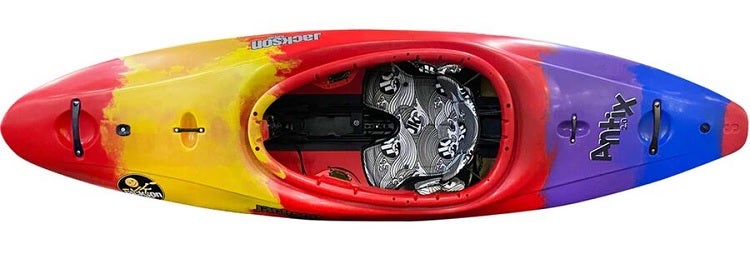 | Three Sizes ( 7ft 7in, 8ft, 8ft 5in) | 34-42 lbs | 160-230 lbs | Polyethylene |
| Jackson Kayak Rock Star 4.0 Kayak | 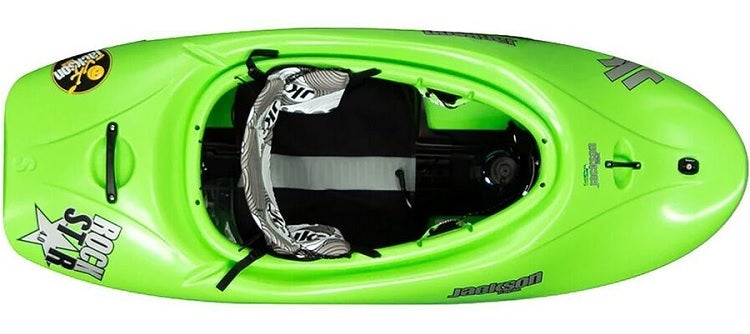 | 7’ 8” | 27-34 Pounds | 150-250 lbs | Not specified |
| Driftsun Rover Inflatable Tandem White-Water Kayak | 12.5′ | 28 lbs | 600 lbs | 1000D Reinforced Layered PVC | |
| Dagger Torrent Sit-On-Top Whitewater Kayak | 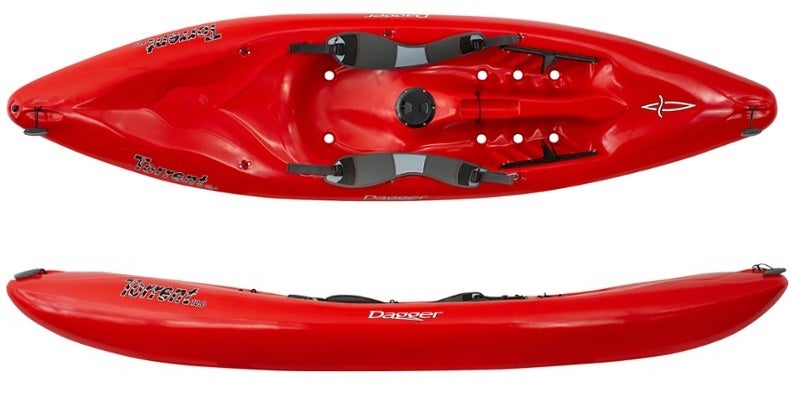 | 10’ 1” | 48 lbs | 250 lbs | Polyethylene |
| Liquid Logic Remix 47 Whitewater Kayak | 7’ 3” | 28 lbs | 110 lbs | Not specified | |
| Dagger Nomad 9 Sit Inside Whitewater Kayak | 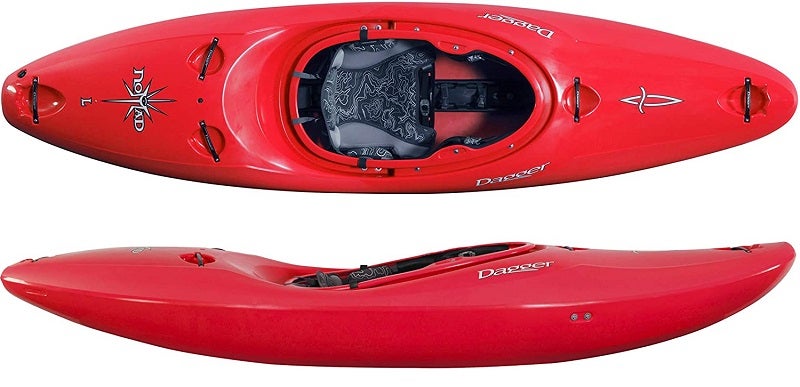 | 8’ 11” | 51.5 lbs | 170-265 lbs | Polyethylene |
| Dagger Green Boat Whitewater Long Boat Kayak | 11’ 9” | 55 lbs | 260 lbs | Polyethylene |
How to Choose the Best Whitewater Kayak for You
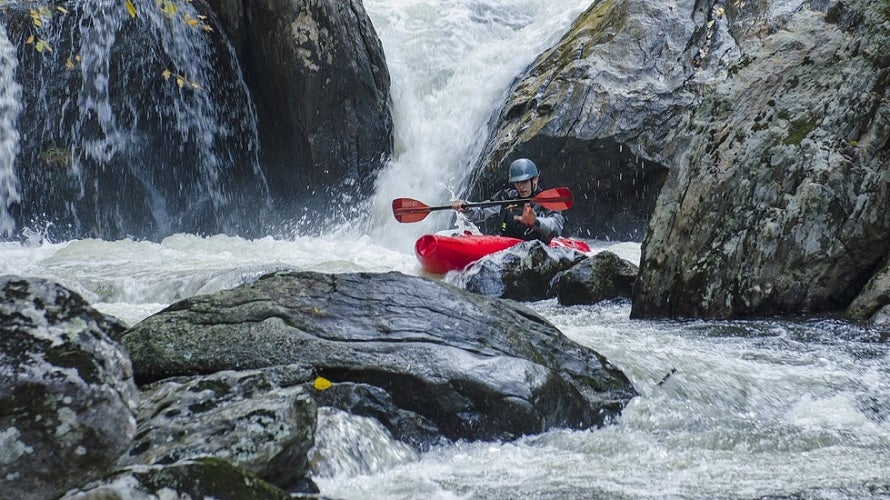
Figuring out what makes each whitewater boat unique and different is critical to making the right choice.
While an entire book could be written about the details of kayak construction and materials, we’ll keep it simple here.
Chines
Chines sit below the waterline of a kayak. These design features can range from hard, rigid structures molded into the boat’s hull to soft, rounded contours.
The type, style, and shape of chines on your boat will directly impact performance.
If you were to look at a boat head-on, one with hard chines would seem to be square-shaped. Hard chines perform extremely well and respond fantastically to control and input.
However, they’ve not very forgiving. Hard chines catch current quickly and, for beginners, can be hard to control because they’re so responsive.
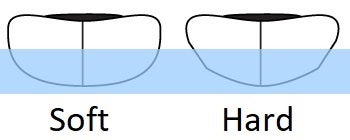
Kayaks with soft chines have a more rounded appearance. Currents and water flow more readily around them and provide a more forgiving experience on the water.
These boats glance better off of rocks, river bottom, and other unpredictable occurrences.
Because of the rounded shape, however, soft chine boats don’t respond as well to tipping and edging movements, making them overall less agile.
Rocker
Think of a banana. Most bananas are gradually curved over their entire length. This is an example of continuous rocker. Rocker simply refers to the shape of a boat being upswept at both the bow and stern.
Not all rocker is equal, however. Kick rocker is an example of rocker design where the bottom of the boat is relatively flat and the bow and stern veer up sharply to form rocker at the very ends.
More rocker means less of the boat is in contact with the water during normal paddling. This results in an overall increase in agility and turn response.
There are so many subtle variations of rocker profile available across a range of boats that it would exceed the scope of this article to cover them all.
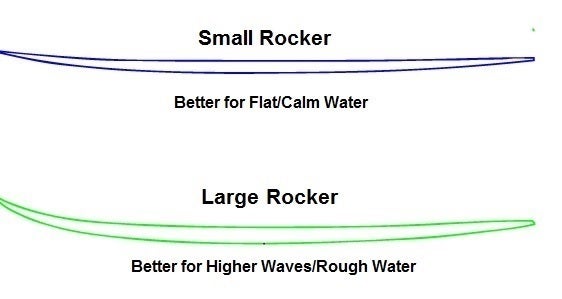
Hull Design
Hull design refers to the general shape of the outside profile of your boat. A boat’s hull is the outermost structural component of any boat.
Planing Hull
Boats with a planing hull feature a prominent flat section at the center of the boat. These boats ride high in the water at speed.
The faster you paddle, the more these boats will skim to the top of the water. Think of it like skipping a flat stone across the water.
The lack of a keel, or centerline, makes these boats difficult to track straight in the water.
Displacement Hull
Displacement hull boats are far more common. You’ll see these on recreational kayaks all the time.
Displacement hulls are rounded with continuous curvature along the bottom from front to back and side to side. There are no flat spots on a displacement hull.
Because these boats have a more defined keel, they do a much better job of tracking straight but sit lower in the water.
Volume
Volume in whitewater boats refers to the total submerged displacement of a boat. Think of it as the amount of water it would take to fill up a kayak inside.
High volume boats usually have pronounced bulbous ends. These boats pop back to the surface quickly and shed water with ease.
They’re common for both beginners kayaks and experts alike as they’re typically the boat of choice for difficult water.
Low volume kayaks look pinched at the front and back. They are easy to submerge which makes them ideal for tricks and freestyle, but a poor choice for difficult water or beginners.
Currents can easily sweep over the low, flat bow and stern and inexperienced paddlers run the risk of losing control.
Stability
With kayaks, there are two types of stability.
Primary Stability
This is a measure of how hard it is to flip over an upright boat in motionless flat water. A kayak with high primary stability, such as a wide planing hull boat, will be quite stable at rest.
Primary stability goes out the window when a kayak gets tipped or edged on to its side.
Secondary Stability
Tip a boat on its edge and you begin to incur secondary stability. This helps stabilize and control the boat when you purposely, or accidentally, tip the boat up on edge.
Boats with thin cross-sections near the gunwale or sidewall will have poor secondary stability. The more area a boat has on its sides, the better its secondary stability.
Types of Whitewater Kayaks
Freestyle Boats or Play Boats
Short boats at about 6-7’ long, these kayaks feature prominent planing hulls. They’re great for tricks, aerials, and other fun moves.
That said, they lack the downriver potential of some other boats. This is due to the short, squirrelly planing hull. Typically these boats have very low volume and are shaped to allow for crazy vertical tricks.
River Running Playboats
These kayaks split the difference between the “for fun” attitude of a freestyle boat and the performance attitude of a river runner.
They’re longer than freestyle boats but usually shorter than a full river runner.
These boats may have a combination of feature to make them balanced between downriver paddling and playing around in the fun stuff.
River Runners
At 7-9 feet long and flatter in profile than the more playful boats, river runners excel at moving through water. These boats are great at covering long stretches of river.
Thanks to their longer hull and flatter profile they also track much better than freestyle boats or playboats.
These may be the most versatile type of boat covering everyone from beginners to advanced paddlers.
Creek Boats
Creek boats feature extremely high volume hulls with a somewhat symmetrical shape. With short, stubby nose and tails these boats are great at taking abuse.
They surface fast and turn on a dime thanks to the often generous rocker profile amongst most creek boats. Creek boats should be sized to length depending on the size of your local water.
Kayak Materials
Polyethylene is an affordable, semi-flexible kayak material common in recreational boats.
While the material itself is prone to degrading in sunlight over long periods (don’t store it in sunlight) it’s also quite durable and holds up well to hard use bumping and scraping river objects.
Polycarbonate may be more efficient than polyethylene but it’s not as forgiving. Between the two materials polyethylene is more durable and therefore tends to be a more common choice.
Inflatable kayaks can be made from several materials.
Neoprene, vinyl, and PVC are common inflatable kayak materials. Whichever you choose, just make sure to look for reinforced hulls and thick, rugged materials.
Beginners Rules For Whitewater Kayaking
FAQs About Whitewater Kayaks
Q: Do I need training before whitewater kayaking?
A: Yes.
Okay, in reality there’s nothing legally obligating you to do so.
That said, however, whitewater kayaking does have an inherently high degree of risk. Without training or experience it’s all too easy to get yourself hurt or killed.
By far the best way to get training is through organizations like the US National Whitewater Center or your local outfitter offering guided trips. There’s a lot to know before you set off on your own.
Never paddle alone, and never attempt whitewater kayaking without training.
Q: What length boat should I start with?
A: That’s a tough question to answer.
If you’re paddling tight creeks, looking for agility, or want to be able to rip out some sweet freestyle stuff you’ll probably want to go shorter.
If your local river has long stretches of flatwater between runs you might consider a longer boat. Longer boats cover distance better but may not be as agile in the rapids.
At the end of the day it’s a very personalized decision and will depend on you, your style, and your local water.
If you’re unsure, try contacting your local outfitter and asking if you can demo different boats to find out which length and style you like the best!
Q: Can I store my kayak outside?
A: Yes, you can. There is one major consideration before doing so, however.
Storing your kayak outside keeps your garage or house from filling up with bulky kayaks. However, the elements can do a number on kayaks over time.
If you’re going to store your boat outside make sure it’s out of the sun. In a shed, carport, or even under a tarp on a trailer is better than direct sun exposure.
Over time UV rays from the sun can damage and weaken the plastics used to make kayaks.
Q: Do whitewater kayaks come with paddles?
A: Generally not.
Whitewater paddling requires that your paddles be sized properly to fit you. If you use a general or cheap basic paddle you may not get the performance you need.
If your paddle is too long it will be unwieldy. Too short and you’ll not be able to generate enough power.
It’s worth investing in a good paddle that’s sized properly for you before you hit the water. After all, a boat is only as good as its motor and, in this case, that motor is your paddle.
Q: What do I do after I take a class?
A: Great, you got some training and took a class. You’re on your way to paddling regularly!
Next up is to find some other paddlers and join them regularly. Ask around for a club or group. Hang out at the local outfitter and ask if they have group sessions or if there’s an established group you can join.
The best thing you can do right now is frequently paddle with experienced kayakers who know your local water.
If you’re lucky you may have a nearby whitewater center with frequent events and meetings. Call around, ask questions, be curious, and be open to new experiences but never paddle alone!
Final Thoughts
Whitewater kayaking is an amazingly fun sport. Every year new boats hit the market and technology improves slowly.
Whether you want the bleeding edge tech and the newest boat or a tried and true workhorse, there’s something on our list for you.
Without a doubt the best way you can get started is to take some classes, learn, and have fun.
When you’re ready to buy your own boat just revisit our “how to choose” section so you can brush up on the technical aspects.
We’ve tried to include options that can help anyone find their next whitewater kayak on our list today. Don’t be afraid to make a purchase and get out there!
How We Researched
To come up with the top whitewater kayaks we researched a variety of sources for reviews such as REI, Dicks Sporting Goods, Cabelas and Backcountry along with our own personal experience.
We also consulted online magazines for product research and reviews to get as much unbiased information as we could. To help weed out fake reviews we used Fakespot.com to make sure we only looked at genuine reviews.
With so much quality gear available, we had to narrow it down based on what we felt were the best options for the price. The author, Casey Fiedler has been an avid kayaker and leads kayak camping trips during the summer months in his native state of Michigan.
To help narrow down the selection he used his personal experience along with recommendations from kayak tour guides and rental shops.
After extensive research, we came up with our list to help you choose the right one for you.
Sources

